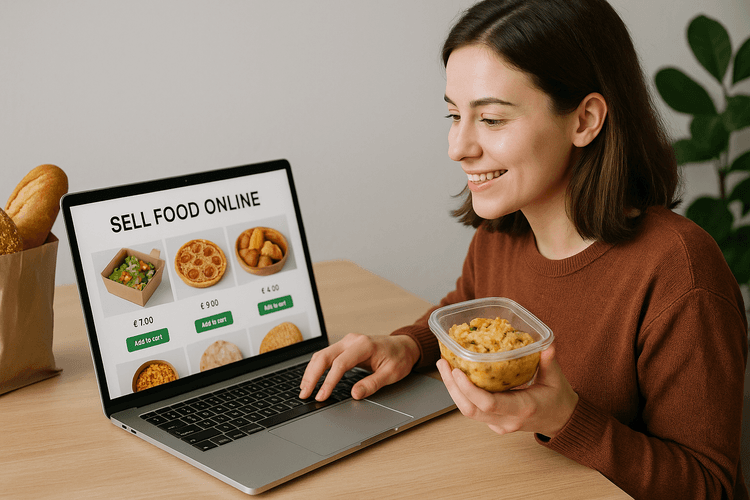
Selling food online has become increasingly popular over the past few years, especially due to the growing trend of online shopping.
If you own a catering business or produce artisanal food, selling online can be an effective way to boost sales and reach a wider audience. In this article, we will show you how to use Framework360 to create your own e-commerce site for selling food.
How Framework360 Can Help You Sell Food Online
Framework360 is a comprehensive digital marketing platform that offers numerous tools for creating and managing your e-commerce site independently. Thanks to its intuitive interface, you can easily customize your e-commerce site and add your products in just a few steps.
- Add your online menu: you can create a dedicated section for your menu with all available dishes for order. You can also include detailed descriptions of the dishes and photos to make them even more appealing.
- Manage your orders: receive orders directly from your e-commerce site and handle them easily thanks to the integrated features of the platform.
- Promote your special offers: create exclusive promotions for your customers and highlight them on your e-commerce site. You can also send out regular newsletters with all the current offers.
With Framework360 you will have everything you need to manage your food selling business online in a simple and effective way.
Identifying your target audience

Before selling food online, it's important to identify your target audience, which is the public you want to address. This step is crucial in order to develop an effective marketing strategy and achieve good results.
Analyzing the market
Let's start by analyzing the market you want to enter. You need to evaluate the competition, current trends, and consumer needs. For example, if you want to sell vegan food online, you need to understand how many companies already offer these kinds of products and what are the current trends regarding the vegan diet.
Defining the average age of the target audience
It's important to define the average age of the target audience. If it consists of a younger demographic, for example, using social networks to promote products can be beneficial. However, if our target is made up of more mature individuals, we might opt for other marketing strategies, such as advertising in newspapers or specialized magazines.
Considering consumer interests
We must also consider the interests of consumers. For instance, if we want to sell organic products, we can focus on themes related to sustainability and environmental health. Conversely, if we deal with regional specialty foods, we can leverage people's interest in culture and culinary tradition.
Using available data
To identify our reference target market, we can use the data at our disposal. For example, if we already have a presence in the market with a physical store, we can analyze the characteristics of our regular customers. Alternatively, we can use digital tools like Google Analytics to understand the characteristics of users who visit our website.
- Defining the target audience is essential for developing an effective marketing strategy;
- It's necessary to evaluate the competition, current trends, and consumer needs;
- It's important to define the average age of the target and consider the consumers' interests;
- Data at our disposal can be used, both from physical stores and those provided by digital tools;
Choosing the right platform

Choosing the right platform for your food e-commerce is crucial for the success of your online business. There are many options available, but not all platforms are equal. Here are some factors to consider when choosing:
1. Ease of use
The platform you choose should be easy to use both for you and your customers. Make sure it's intuitive and offers a seamless user experience.
2. Inventory management
Make sure the platform allows you to easily manage your inventory, adding or removing products and tracking stock levels in real time.
3. Secure payments
The platform should provide a secure payment system for your customers, such as PayPal or credit cards.
4. Marketing features
Look for a platform that offers integrated marketing features, like sending promotional emails to your customers or the ability to create coupons and discounts.
5. Technical support
Choose a platform with good technical support, so you can quickly and efficiently resolve any issues or questions about your online business.
- Example: If you have an online sweet shop, you might choose the Framework360 platform, which offers all of the above-mentioned features and allows you to create your own e-commerce site independently.
Remember that choosing the right platform depends on your specific needs and business goals. Do thorough research before making a decision and make sure to pick a platform that can support your long-term success.
Create an effective marketing strategy

Once you have set up your e-commerce site with Framework360, it's important to develop an effective marketing strategy to attract customers and increase sales.
Identify Your Target Audience
Firstly, you need to understand who your potential customers are. For instance, if you sell vegan food, your target audience will be people who follow this diet or an eco-friendly lifestyle. By identifying your target audience, you can create content and promotions specifically for them.
Create a Blog
Creating a blog on your e-commerce site can be a great marketing strategy. Write interesting articles about your products, share recipes or useful cooking tips. This way, you'll draw traffic to your site and build your reputation as an expert in the food industry.
Leverage social media
Social media is a great platform for reaching your target audience. Create business pages on Facebook, Instagram, or Twitter where you can share images of your products and interact with your followers. You can also use paid advertising on these platforms to reach an even wider audience.
Offer discounts and promotions
Discounts and promotions can encourage customers to purchase your products. For example, offer a 10% discount on the first purchase or create promotional bundles with various products.
Collaborate with influencers
Collaborating with influencers can be very effective in the food sector. Look for public figures who have a following similar to your target audience and propose that they test and review your products on their social channels.
- Identify your target audience;
- Create a blog on your e-commerce site;
- Leverage social media;
- Offer discounts and promotions;
- Collaborate with influencers.
Captivating photos and descriptions

The presentation of products is key to capturing the attention of potential customers. The photographs should be high quality, bright, and sharp, so as to showcase the food in the best possible way.
In addition, descriptions must be precise and detailed, providing all the necessary information about each product.
For example, if you are selling a chocolate dessert, the description should include not only the main ingredients but also information about the size of the dessert, its flavor, and texture. This way, customers will have a complete understanding of the product before making a purchase.
Many people are attracted by images of appetizing food, especially on social media. Therefore, it's important to use photos that make customers' mouths water. For instance, if you are selling a margherita pizza, you could take a picture of the hot pizza with melted cheese stretching in strings as it is being sliced.
In summary, the photographs and product descriptions must arouse customer interest. They should present the products in their best light and evoke positive feelings associated with taste and satisfaction.
- Use high-quality photographs
- Highlight the key features of the products
- Include information on size, flavor, and texture of the products
- Stimulate appetite with enticing photographs
Managing shipping and logistics

The management of shipping is a crucial aspect for anyone deciding to sell food online. Without an efficient delivery system, customers might have issues purchasing your products and may prefer other online stores with shorter delivery times.
Framework360 offers you various options to manage shipping and logistics for your online store. Once registered on the site and having created your e-commerce environment, you can access the “ Shipping from the left menu.
Setting up shipping rates
In this section, you can configure shipping rates based on destination, package weight, and order price ranges. For example, you can decide to offer free shipping for orders exceeding a certain amount or apply a fixed rate regardless of the package's weight.
We recommend researching your competitors' shipping rates to get an idea of the market prices. This way, you can provide competitive rates to your customers without compromising your profit margins.
Choosing the right courier
Once you have configured the shipping rates, you need to choose the right courier to deliver your products to customers. Framework360 works with several couriers, including SDA, UPS, and GLS.
The choice of courier mainly depends on the type of product you sell, the destination of the shipment, and the prices charged by the courier itself. For instance, if you sell fresh products that need to be delivered quickly, we recommend choosing a courier with express delivery.
Managing delivery timelines
The delivery timelines are another important aspect to consider when managing shipments. Customers want to receive their purchases as soon as possible, so it's crucial to ensure a fast and efficient delivery.
In this section, you can set up the delivery timelines for each destination and each courier. For example, you can choose to offer standard delivery within 2-3 business days or express delivery within 24 hours.
Tracking shipments
Once a shipment is made, it's important to monitor the order status until it is delivered to the customer. Framework360 allows you to track all shipments through your online store's control panel.
You can view the order status in real time and contact the courier in case of issues or delays in delivery. This way, you can provide your customers with an effective and reliable after-sales service.
- Summary:
- Set up shipping rates based on destination, package weight, and order price brackets
- Choose the right courier to deliver your products to customers
- Manage delivery timings for each destination and courier
- Monitor shipments through your online store's control panel
Providing an impeccable customer experience

To be successful in selling food online, it's not enough to just offer quality products, but it is crucial to provide an impeccable customer experience. Here are some tips on how to do so:
- Attractive website design: your website's design should be appealing and intuitive for customers. Use high-quality images of your products and ensure navigation is easy and fast.
- Secure payment: customers need to feel safe when making a purchase on your site. Make sure to use secure payment platforms such as PayPal or Stripe.
- Fast and reliable shipping: the shipping service is a crucial point in the purchasing process. Make sure to offer fast and affordable shipping options, and always provide an accurate estimate of delivery times.
- Efficient customer service: respond quickly to customer questions and issues. Provide a toll-free number or a dedicated email for customer support.
- Loyalty programs: offer loyalty programs to your customers, such as special discounts or bonus points for purchases made. This will encourage customer retention and increase the chances they will return to buy from your site.
An example of how to implement some of these suggestions might be to offer free shipping on orders over a certain amount. This way you encourage customers to buy more products and at the same time make them feel appreciated since you are offering them an additional benefit.
Always remember that customer satisfaction should be at the heart of your online sales strategy. Offer them an unforgettable experience and you will see success come!
Selling food online can be a great business opportunity, especially in a historical moment where online sales are constantly growing. Thanks to the Framework360 platform, it is possible to create your own e-commerce site easily and intuitively, customizing every aspect of your store.
To successfully sell food online, it's important to offer products of quality and distinction, that stand out from the competition. Moreover, attention to detail and an attractive presentation of your specialties can really make a difference.
Using features like campaigns with automations can also help in customer loyalty, by sending personalized newsletters and targeted promotions.
Ultimately, if you have a passion for food and cooking, selling online can be the start of an exciting entrepreneurial activity. With Framework360, it is possible to do so with ease and professionalism.
Conclusion:
Selling food online requires commitment and dedication but can represent a great business opportunity. Choosing a reliable platform like Framework360 allows you to launch your own e-commerce site with security and efficiency. Always remember the importance of the quality of the products offered and attention to detail in order to stand out from the competition. Use the available features, such as campaigns with automations, to retain customers and increase sales.
- Register now on Framework360: https://www.framework360.com/try-free/
- How to open an e-commerce site with Framework360: https://www.framework360.com/how-to-make-an-ecommerce-website/
You can do it too, you just need a lot of commitment and an excellent marketing and sales platform.
Free trial for 30 days. No credit card required.







